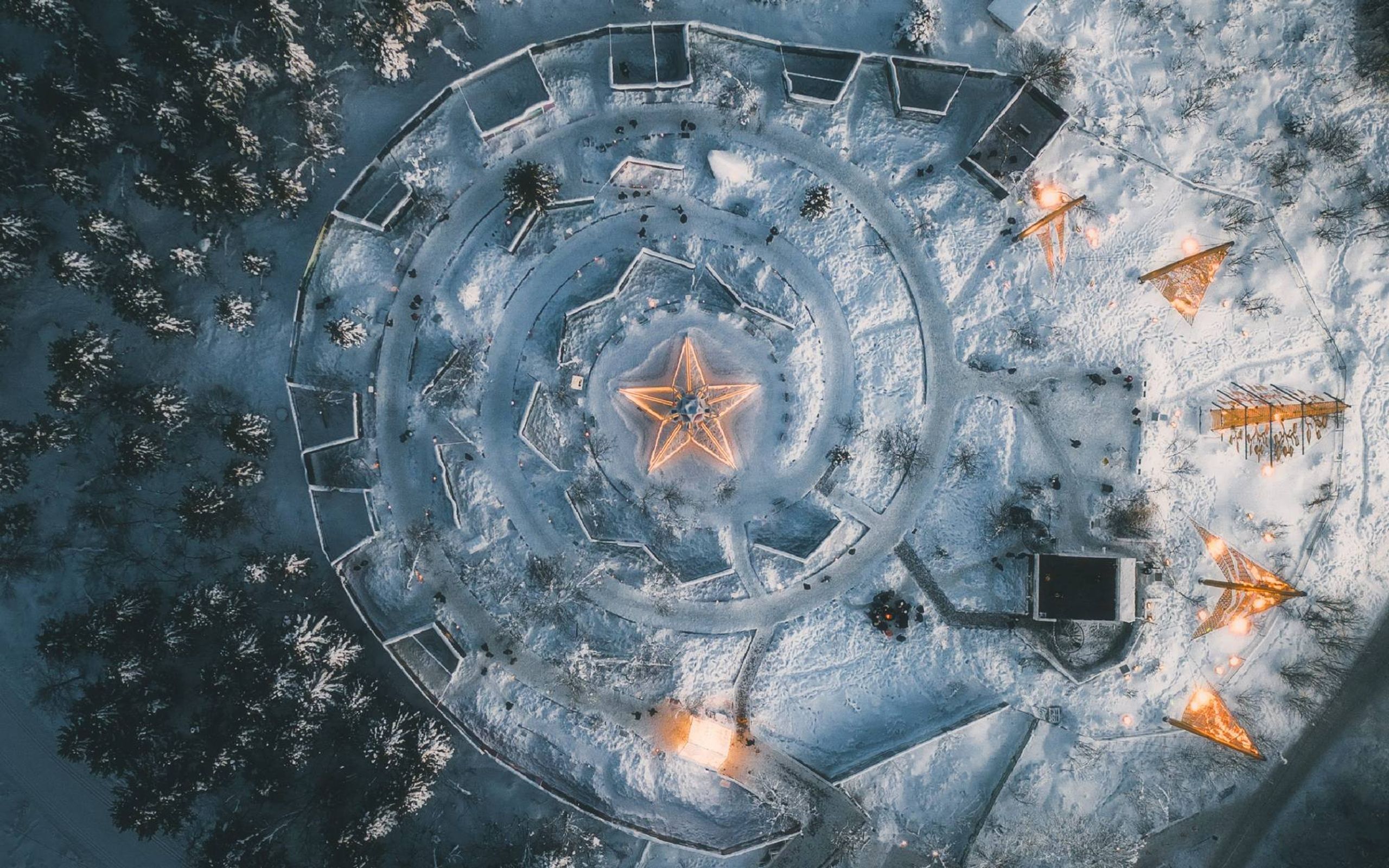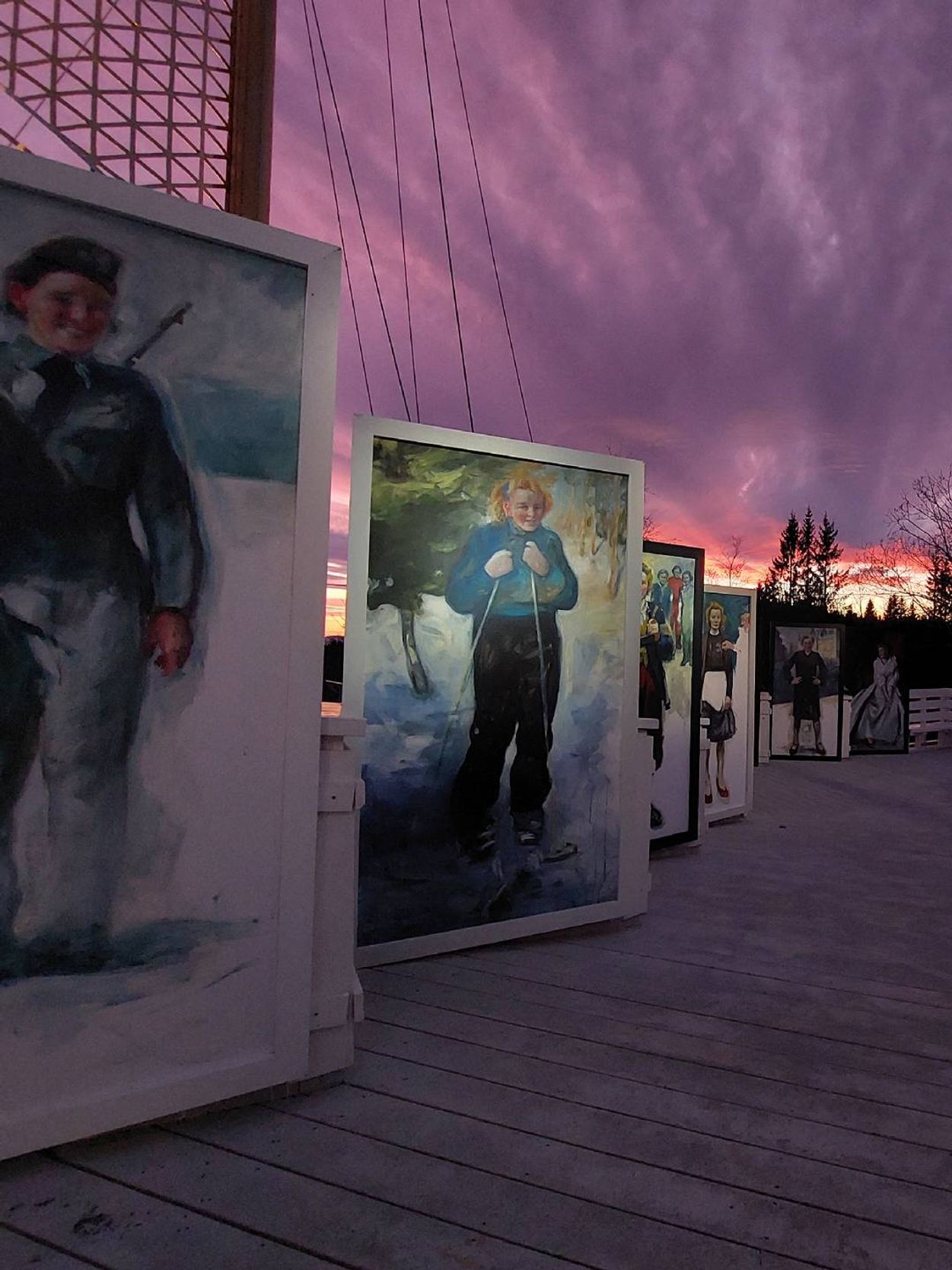An Art Park in Norway Honors Freedom — and a Grim Wartime Occupation
Oslo's Rose Castle pays tribute to the country's history and many of the people who were instrumental in the resistance during World War II
Five golden tree-shaped spires rise from a tree-blanketed hill like something in an enchanted forest, illuminated at night, and glistening amid winter snow. It's the Rose Castle, an extraordinary art park in Oslo, Norway, dedicated to freedom, democracy and preserving the memory of the country's five years of German occupation during World War II.

Over 200 paintings and sculptures by two Norwegian artists, Vebjorn Sand, 56, who lived in New York for 17 years, and his brother, Eimund Sand, 53, line a circular wooden walkway with a glorious view overlooking Oslo Fjord in the Holmenkollen ski area.
You can read the stories of people like Astrid Linderud, the youngest border guide in Norway, who from age 9 on helped refugees cross the border to neutral Sweden.
Some are portraits of anti-Nazi resistance heroes in Norway. One is a giant sculpture of a white rose, since the park is named for an anti-Nazi group of students and a professor in Munich, The White Rose. (Its sole survivor lives in South Carolina, Traute Page, age 103, whose portrait is next to the rose sculpture.) Others are geometric installations inspired by Renaissance humanists' fascination with the harmony of geometric shapes.
At a time when freedom and safety are under threat across the globe, it's inspiring to hear about the power of individuals who resisted evil, and the power of art to communicate this.
"The one that sleeps in a democracy, will wake up in a dictatorship," reads a quote in the park from Otto Grischneder, a German historian who chronicled the Nazi regime, summing up Rose Castle's mission.
'A Celebration of our Freedom Values'
"The Rose Castle is a celebration of our freedom values, which are again under pressure, a call to everyone to be awake, stand up against hate, intolerance and totalitarian powers, and never take freedom for granted," says Vebjorn Sand. "We let people who experienced the brutality of totalitarian powers come to life through portraits and text."
The art park, which opened in 2020 in honor of the 75th anniversary of Norway's liberation from occupation in 1945, remains open through 2025.
The United Nations declaration on human rights, which is next to a star-shaped installation, is read to groups on guided tours. School children are especially welcomed. "They should learn about what we must never forget about the war, and realize they are the ones who will carry freedom values to new generations to come," says Sand.
"I'd say I've gotten more than fifty new friends since 2018 that are around 100 years old."
You can read the stories of people like Astrid Linderud, the youngest border guide in Norway, who from age 9 on helped refugees cross the border to freedom in neutral Sweden. And Herman Kahan, a Norwegian 18-year-old found in a concentration camp in Ebensee, Austria, when an American soldier who helped liberate the camp walked by a pile of dead bodies, saw a hand moving, and pulled him out.
Mykhailo Sidelnik, a prisoner of war who worked as a slave in Norway during 1943-45, was seized by the Germans during the battle of Stalingrad; heading back to Ukraine in 1945, he was arrested crossing the border and sent to the Soviet Gulag for seven years. "Stalin expected his soldiers to [die by] suicide before surrendering," notes Sand, who went to Ukraine in 2020 to meet Sidelnik, then 98.
"I'd say I've gotten more than fifty new friends since 2018 that are around 100 years old," says Sand, adding that sadly, most of them have died.
The Rose Castle is 80% self-funded. Most of the money needed to build it came from the sale of Sand's New York apartment, as well as sales of his artworks.
"We also received some funding from Norway's Ministry of Culture and Ministry of Defense and private donors, and the companies who built the Castle have given us very good deals. I paid for all the research and trips needed," Sand explains. "It's organized as a nonprofit, and many people from all over Norway worked as volunteers to make it happen. The project has twenty people employed, almost half trained as guides for groups visiting the park."
Surrounded by Symbolism
The five tree-like spires, representing five years of occupation, are, upon closer inspection, all different, each symbolizing a different side of resistance. The golden sail symbolizes the sailors in the Navy. The mountain stands for the resistance in the north of Norway. The pine tree, the resistance hiding in the woods; the combined wing and bird feathers, the Air Force and the illegal press.
In the center, the birch tree, the largest, represents King Haakon VII, who said no to collaboration with Nazi Germany, and Norway's Constitution.

"The Nazis tried to kill our King, and while he was escaping, he and his son were photographed next to a birch tree. Since then, the birch is a freedom symbol in Norway," Sand explains. "The Rose Castle is made of gold leaf as a symbol of the precious values that were lost, but that must live forever."
Historians and scholars from museums in Norway helped Sand find survivors to interview across the country, and fact check the information located next to the artworks. One is the Center for Studies of the Holocaust and Religious Minorities in Oslo, which has a special focus on Norwegian Jews. Ironically, it's located in the mansion that was the wartime home of Vidkun Quisling, who headed a collaborationist puppet regime in Norway during its occupation. "Quisling" later became a synonym for "traitor."
Other Oslo museums that helped were Norway's Resistance Museum at Akershus Fortress, which documents the home front resistance to the war (and where Quisling was executed for treason and murder after the war) and Oslo Jewish Museum, located in a former synagogue.
South of Oslo, the Archive, housed in the Gestapo's former headquarters in Kristiansand, Norway's closest port to Denmark, assisted. In Norway's far north, the Narvik War Museum in northern Norway, devoted to the fierce battles in Narvik in 1940, where Germany won control of this port for iron ore mines in nearby Swedish Lapland and the Museum of Reconstruction in Hammerfest, where 75,000 people were evacuated before the retreating Nazi army burned the city to the ground, many living in caves to survive, were instrumental.
An Artist's Appreciation

Sand, who lived in New York from 2000 to 2017 and owned Gallery Sand in the West Village for 10 years, spent four years of research interviewing people all over Norway. Approval to build the project was needed from the Oslo municipality, who owned the land, and the state administrator in the municipality, which took one-and-a-half years.
Sand's other artworks include the Peace Star at Oslo Airport and the Da Vinci bridge project, where he built the genius' 1502 design for a bridge in Istanbul on continents from Europe, North America and Antarctica to Greenland. In New York, in front of the United Nations, he built a temporary ice bridge in 2007. In Norway, it was a laminated-wood bridge.
"I could not have done the monumental paintings in the Rose Castle without the fantastic training and education I got in New York City," says Sand, who studied at New York's Art Students League as well as in Oslo and Prague.
Summer programs at Rose Castle include concerts, from jazz to classical, storytelling and poetry, led by musical director Martin Romberg. It's truly a place to experience the glory of art in all forms, remember history, and never forget.
Read More

